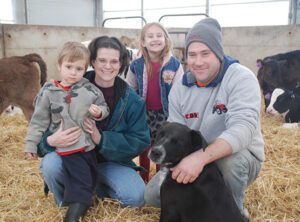Shullsburg, Wisconsin, farmer Chad Gleason is enthusiastic about everything he does — from managing his 400-head steer finishing operation, to growing corn and hay for his livestock with help from Midwestern BioAg.
Gleason farms on a wide variety of soil types — some of them are great like his Tama soil (reputed to be the best soil in the world), and others that are not so great in the hills.
But all of the fields are going gangbusters since he decided to utilize the products and practices recommended by Midwestern BioAg seven years ago.
300-Bushel Corn
“We have some very fertile fields that are producing really well, but we also have some poorer ground that’s yielding great too.” Since he switched to the BioAg program, Gleason said he isn’t surprised to get 300-bushel corn yields.
“I am very impressed. Most people don’t believe me when I talk about my soil tests,” he said. “I’m definitely sold on the results.” He uses his phone to show photos of corn ears as big as his forearm weighing 1.36 pounds each. He hit 301 bushels per acre with those ears, on fields planted in 38-inch rows and a population of 30,500 plants per acre.
Before working with BioAg, 125-bushel corn yields on Gleason’s farm were the norm. He can only marvel at the corn yields he gets now and the rates at which his soil organic matter scores have risen. “I have no soils under 4 percent organic matter now. Many of my soils are 5, 6, 7, even 8 percent organic matter. Most were in the range of 3 percent when we started.”
Since he switched to the BioAg program, Gleason said he isn’t surprised to get 300-bushel corn yields.
Gleason is primarily a livestock man, but believes that good production will follow if the soil is taken care of. “Everything starts with good soils that produce good crops that do good things for my livestock. It’s a cycle — everything works together.”
The main enterprise on the Gleason farm is raising beef cattle. The baby calves and the 400-head steer finishing operation are both on Chad’s 80-acre farm, which once belonged to his great-grandfather. He’s now the fourth generation of his family to farm that land.
Chad farms with his wife Katrina — they have two young children and another on the way — and shares some equipment with his parents Pat and Betty who have their own 200-acre farm nearby. “We have some bigger equipment that we share and we try to help each other back and forth.”
High-Yielding Forage
In addition to working his own land, Chad rents about 100 acres of hay ground. He tries to produce as much feed as he can for his livestock to cut down on purchased feed and save the livestock enterprise money. He generally grows pure alfalfa stands on his fields to produce high-protein hay and save on purchased protein costs. Last year, Gleason took 10.5 tons per acre of dry matter off his hayfields in five cuttings. “I’ve never had so much hay.”
Fields are generally kept in alfalfa for three years and then corn is brought into the rotation for a few years, depending on the price of corn and other factors. Gleason also grows oats for straw and uses the grain in his calf starter. “We try to be as self-sufficient as possible. It’s a lot more work but the savings have paid off.”
His feedlot cattle are fed with a total mixed ration (TMR) utilizing his corn and hay crops. The corn is all harvested as “snaplage” — the grain, cob and husk is harvested with a silage chopper equipped with a snapper head and a kernel processor. Gleason stores his feed in a bunker silo and horizontal silo bags.
Fertility Program
Gleason credits BioAg’s Bio-Cal® with building his soil’s tilth. “Bio-Cal creates humus and humus builds organic matter,” he said.
Gleason’s fields get at least 1,300 pounds per acre of Bio-Cal yearly each fall. “My rented field gets 1,700 pounds to the acre. With a good, balanced fertilizer program and good manure, it all works together.”
His fields are “in the soil corrective stage,” and he knows that eventually this productive phase will slow. “We are at the high end of these soil additives but we are throwing everything at it to see what will happen.”
His fertilizer program includes 32% nitrogen that goes on with his pre-emergent application of herbicide, and then a broadcast of BioAg fertilizer in the spring. He does grid-sample soil testing with BioAg every two years.
When it comes to selecting seed corn, he is “very happy with Master’s Choice for feed.” Nearly all the corn he plants is Master’s Choice — generally 112-day and 118-day corn. “When corn moisture hits 40 percent, the chopper is rolling,” said Gleason.
For 2016, he plans to save money by planting all conventional corn rather than the genetically modified (GM) stacked-trait corn at double the price tag. Last year he experimented with some conventional corn along with his GM corn and didn’t see much difference. “It’s a no-brainer to save that much on seed cost.”
Gleason plans to continue to push his fields with BioAg products to see how much production he can get. He has noticed that when his neighbors have ponding on their fields after rain, he doesn’t; in drought conditions, his crops look green and healthy compared to those of his neighbors. “I’m definitely a believer,” said Gleason. “You can visually see the difference.”

